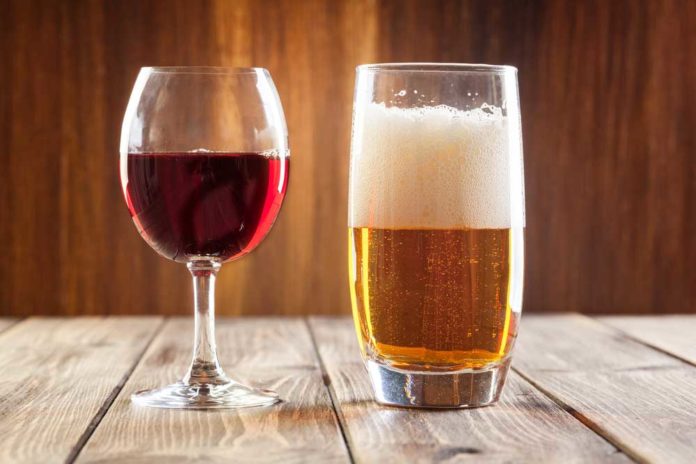When starting any sort of healthy lifestyle or weight loss regimen, eliminating alcohol is a preconceived impression. And with the combination of 200 billion liters of wine and beer consumed across the globe, giving up favorite alcoholic beverages may be a tough bargain. Although drinking alcoholic beverages holds some caution, dieters who enjoy beer and wine may be able to have their drinks and drink them, too!
Battle of the Booze
Before jumping right into the battle of the booze, it may be commendable to gain a general insight of what alcohol truly is. Alcohol ingested, known as ethyl alcohol or ethanol, is produced by fermenting grains and fruits. The fermentation process requires yeast to breakdown the ingredients, subsequently creating alcohol. Interestingly, alcohol is actually sometimes called a food related to its caloric content, offering 7 calories per gram to be exact. It holds a higher calorie load compared to carbohydrate and protein, both containing 4 calories per gram, though lower in calories compared to fat, providing 9 calories per gram. But unlike the other three macronutrients, it is not sincerely considered a proper food in a balanced diet, associated to minimal nutrients necessary to supply and nourish the body. That being said, how do wine and beer differ and is one more beneficial than the other?
Calories in Wine Versus Beer
As mentioned, alcohol provides 7 calories per gram. The recommended serving size of alcohol and their associated calorie content include:
- Beer: 150 calories per 12-ounces of regular or light beer or 8 to 9-ounces of malt beer
- Wine: 125 calories per 5-ounces of red or white wine
- Liquor: 100 calories per 1.5-ounce shot of 80-proof spirits
Beer and Wine on Health
When battling to recognize which alcoholic beverage holds top health precedency, it is important to sift through the research. Evidence shows the pros and cons of each, displayed in the chart below.
| Beer | Wine | |
|
Pros
|
Beer offers valuable nutrients the body utilizes to properly function on a day-to-day basis. Specifically, beer supplies vitamins B6 and B12 along with folic acid.
Beer may lessen the risk of painful kidney stones, suggests a study in the Clinical Journal of the American Society of Nephrology. Step aside, calcium! Beer contains a component known as silicon, usefully shown to increase bone mineral density and improvement of bone strength. Beer has been suggested to improve blood circulation, linking itself to a possible brain protector. In fact, evidence suggests women who drink alcohol (in moderation, of course) may lessen their risk of cognitive decline. Though wine is continually suggested as a heart-protectant, there is small evidence suggesting beer, too, can in fact lower the risk of heart disease. |
Most wine drinkers justify wine over beer related to its notorious resveratrol content. Resveratrol, nonetheless, has exhibited to offer heart-protective characteristics, including the reduction of bad cholesterol and the prevention of blood clots.
Along with resveratrol, wine provides a component known as procyanidin. This subset of tannins has been suggested to support longer life spans. Additionally, red wine may lessen the risk of dementia development. Research suggests drinking wine improves mental health. Specifically, a study published in BMC Medicine found both men and women were less likely to develop depression following wine intake. Studies have implied drinking red wine may protect against cancer. Specifically, red wine has shown to reduce the rates of bowel tumors and the risk of breast cancer. |
|
Cons
|
Though craft beers often offer the highest nutrient content, they are also higher in calories and may lead to that infamous “beer belly.” If trying to lose weight, drinking calories is often discouraged, as they often do not provide satiety the way nutritious foods can.
Though silicon-containing beer may improve bone health, too much of it does not translate to even stronger bones. Research suggests exceeding the daily recommendation actually reduces bone density. |
White wine is considered to be greatly more acidic than red wine, ultimately raising the concern for compromised dental health. In particularly, the high acidity content may damage the precious enamel.
Wine may contain both chemical and biological contaminants, increasing unpleasant symptoms of facial flushing, asthma, and a burning sensation in the mouth. However, reactions and sensitivities do vary between individuals. |
The Equal Threats of Beer and Wine
Though both wine and beer comes with their differentiating pros and cons, the totality of alcohol comes with its own set of cautions. First off, the general guideline for alcohol intake is two drinks per day for men and women are limited to one drink. Exceeding the alcohol recommendation, despite the source, can have harmful consequences on the body. Initial worries are often correlated to the sensation of feeling “high” or “drunk” following high intake, interfering with appropriate function of the brain and central nervous system. Alcohol can further inhibit the liver’s ability to maintain blood sugar levels and interfere with proper nutrient absorption. Depriving the body of essential nutrients, especially when alcohol starts to replace nutritious foods, can ultimately surface nutritional deficiencies (particularly thiamine, folic acid, zinc, and vitamin A) and create the risk of cancer, gout, heart disease, fatigue, anemia, and other health concerns. The diuretic effects of alcohol can further lead to dehydration related to increased urine output. Valuable water-soluble vitamins, including potassium and magnesium, may also be lost in the urine.
Despite the potential benefits of both alcoholic beverages, most health experts agree nondrinkers do not need to pick up the beer or wine bottle to obtain suggested nutrients. But if one bottle is preferred over the other, making a switch is unnecessary. What is necessary, though, is sticking to recommended serving sizes to reduce the risk of a short-term hangover or long-term health consequences. All-in-alcohol, enjoying either wine or beer can fit into a well-balanced diet. Cheer with beer or dine with wine!






